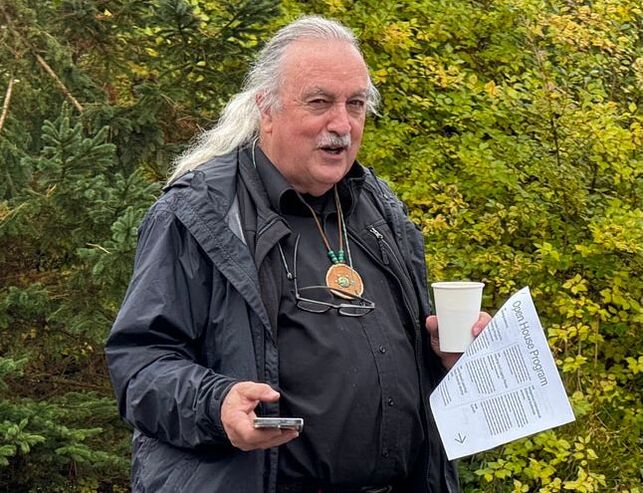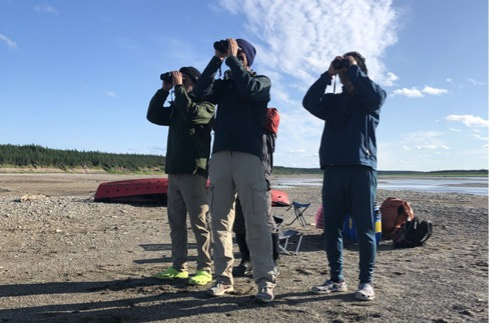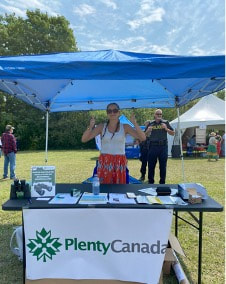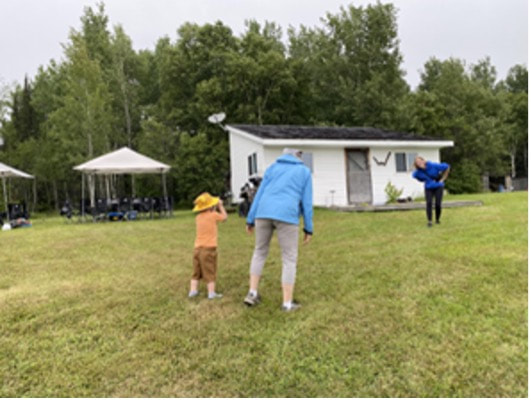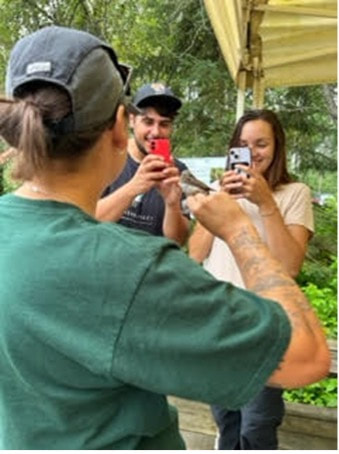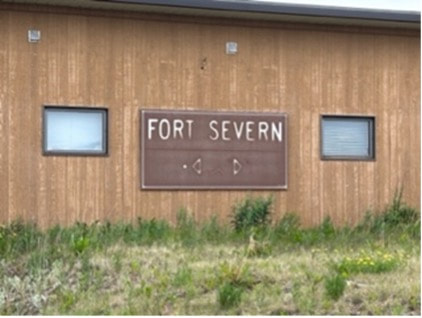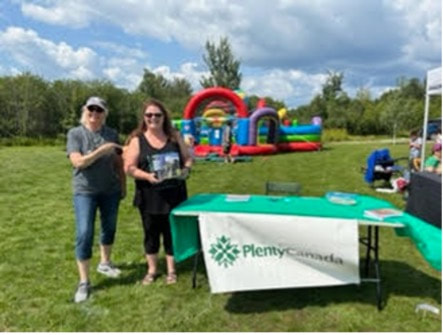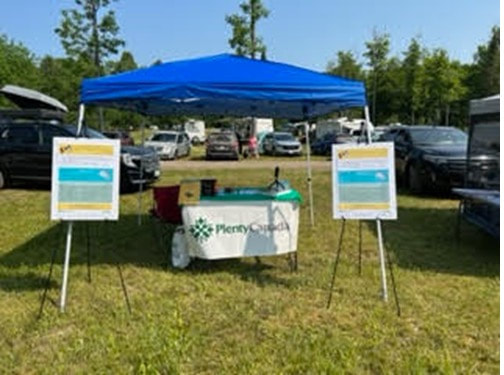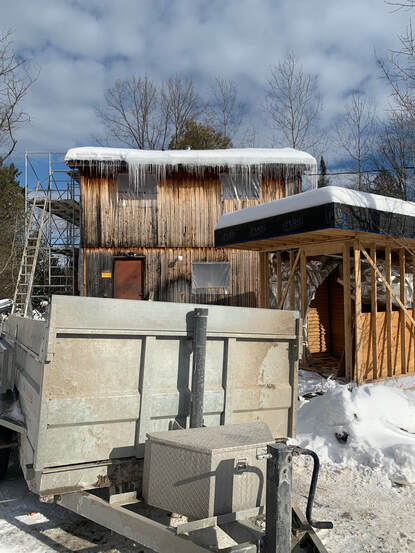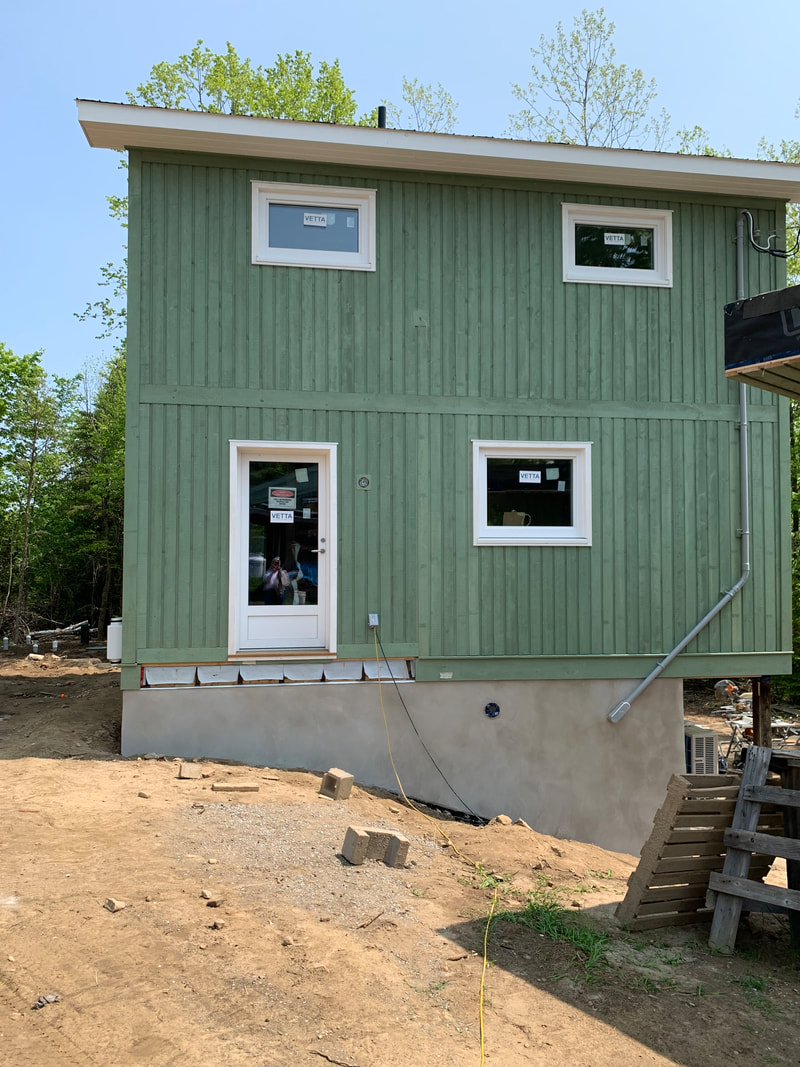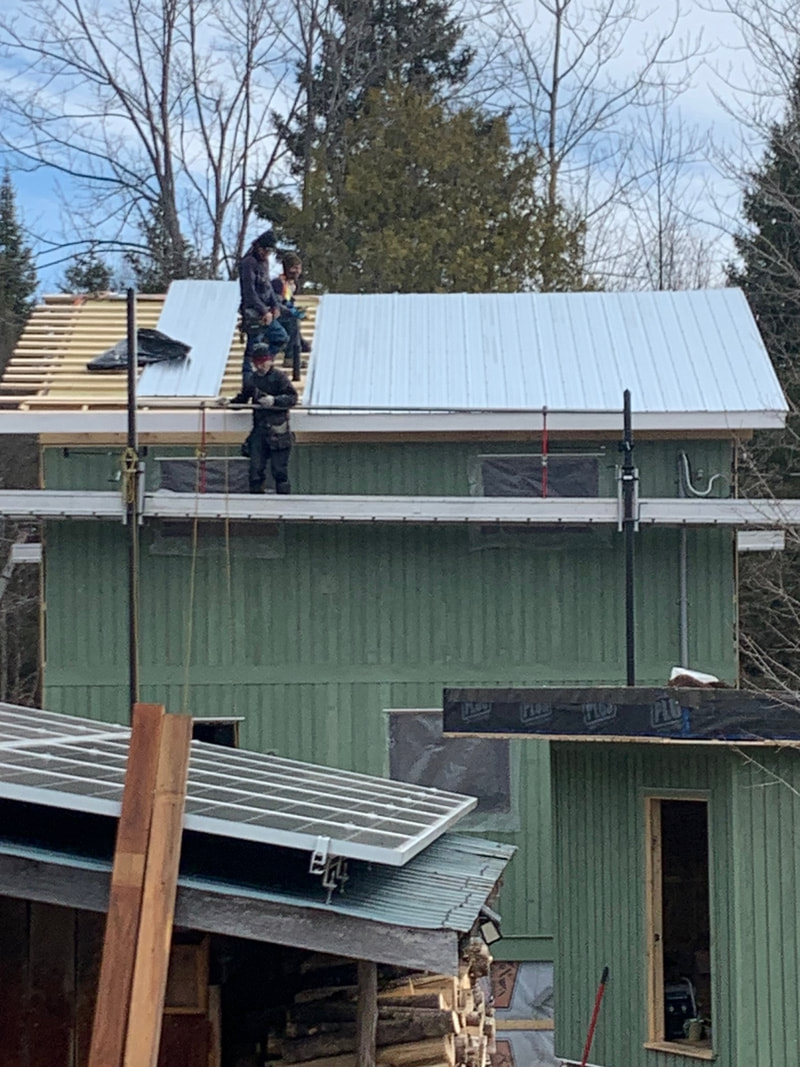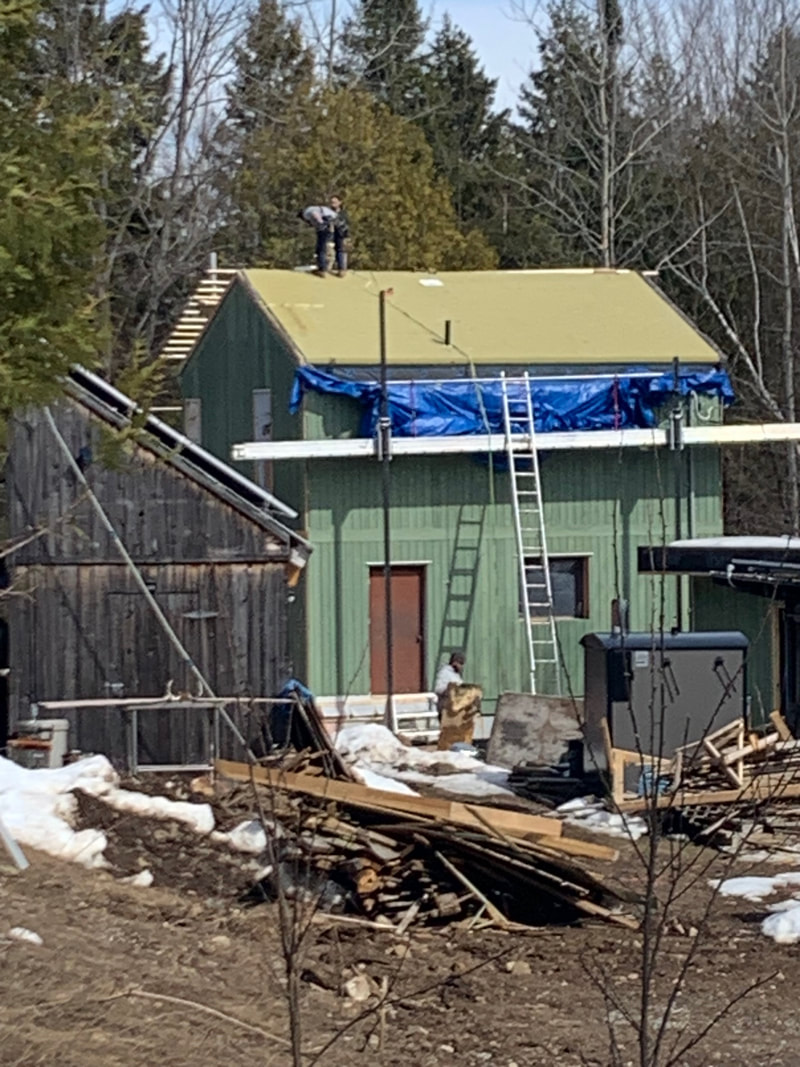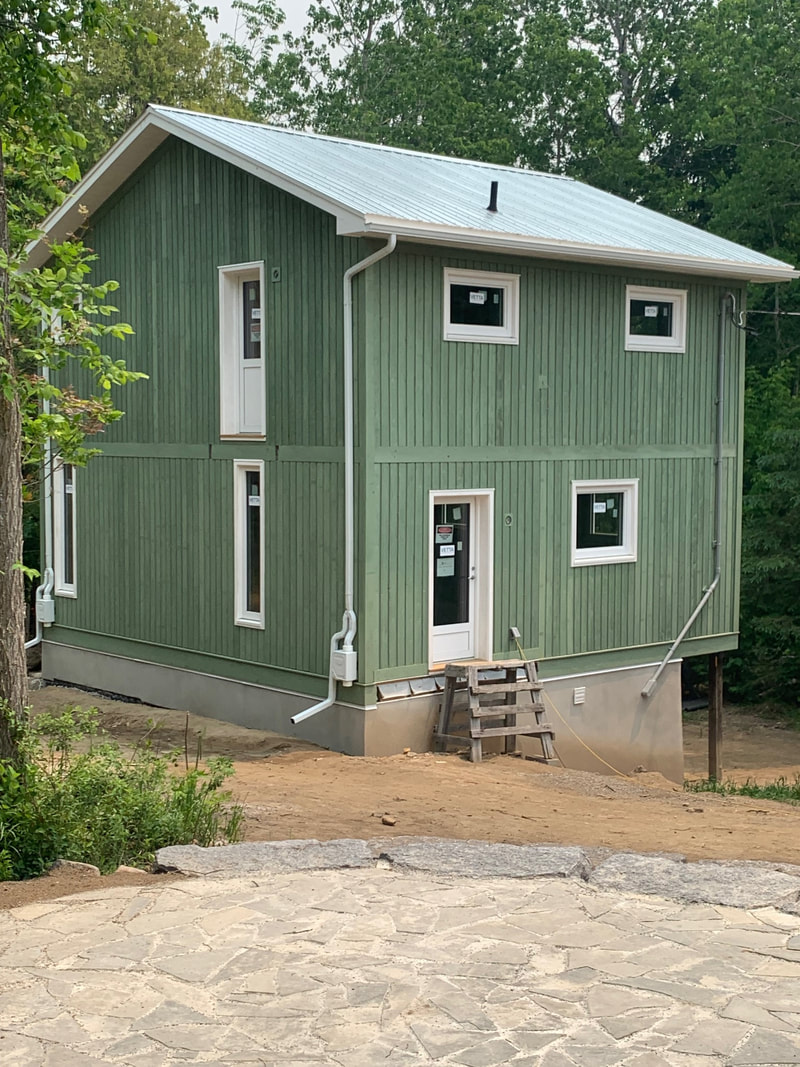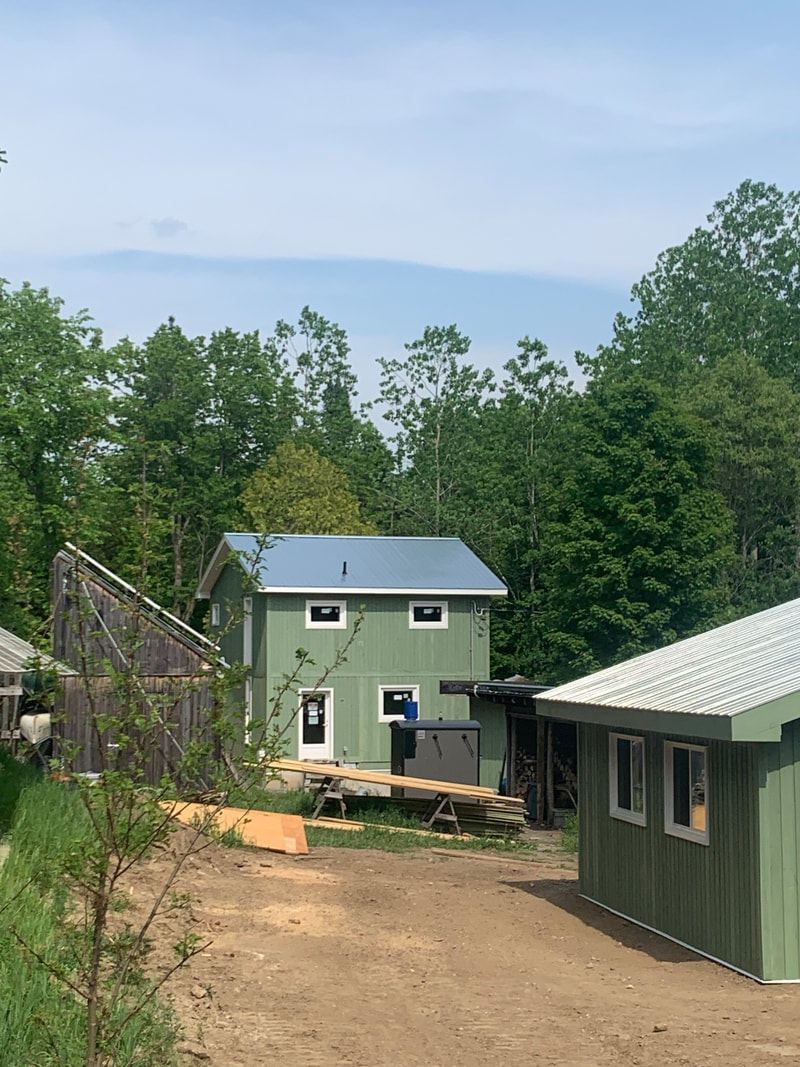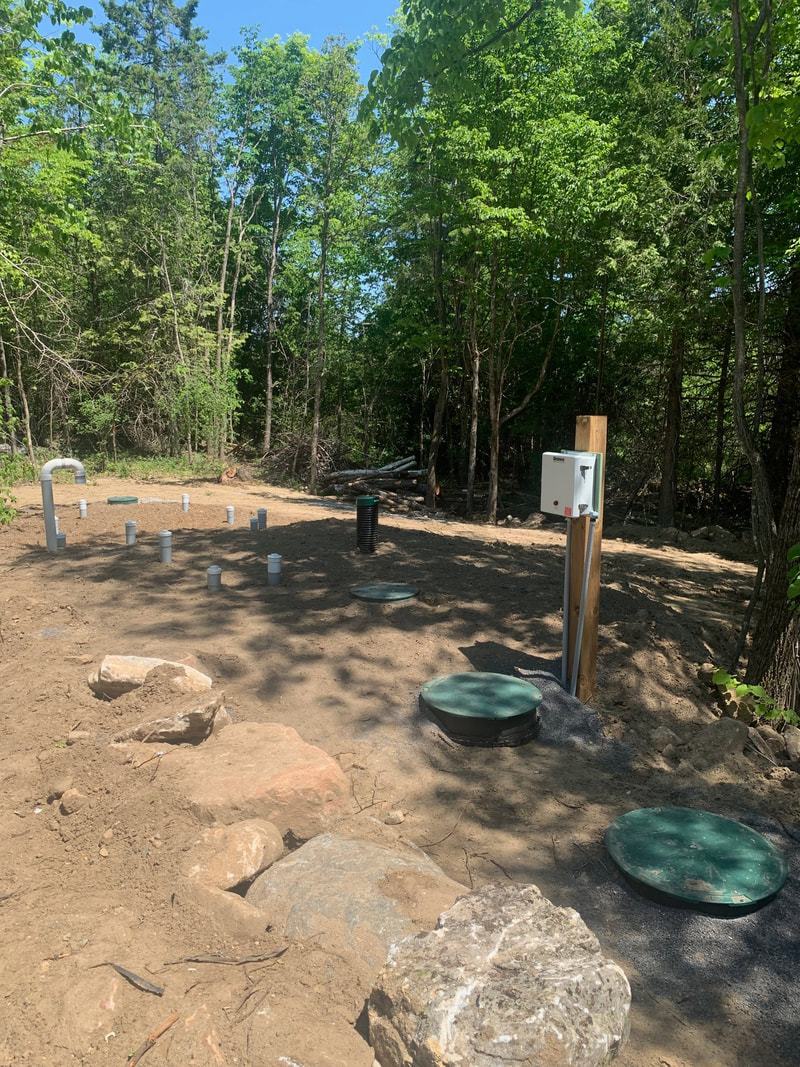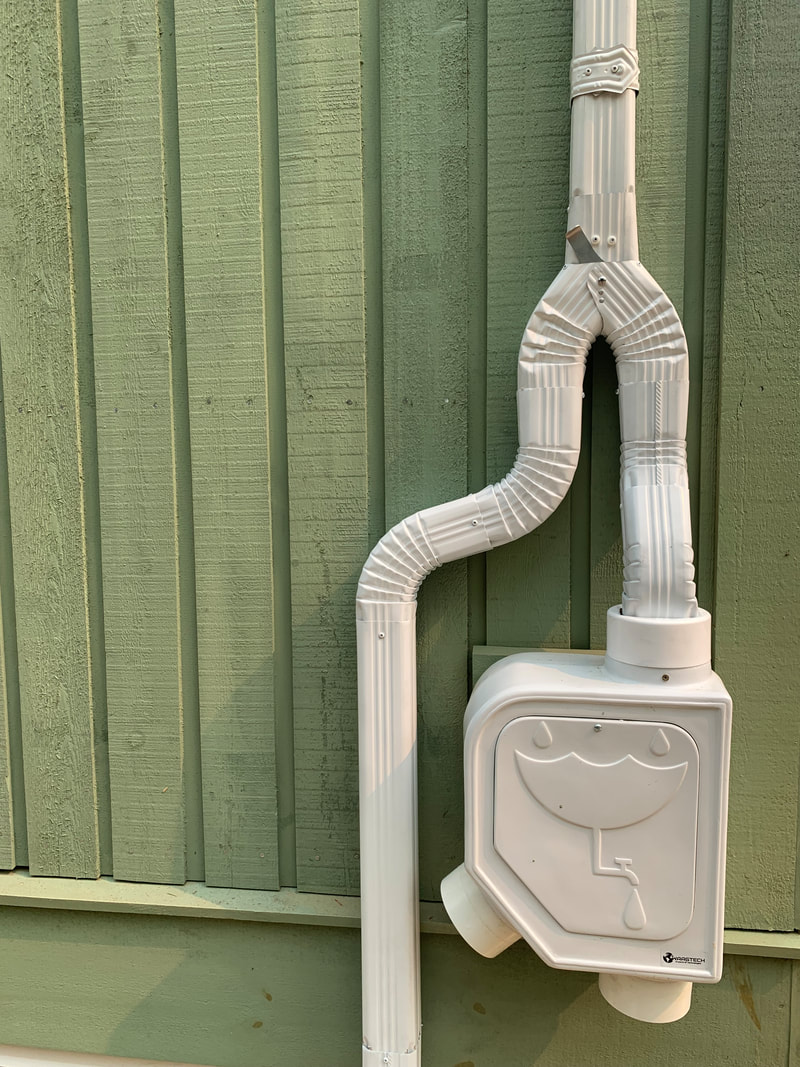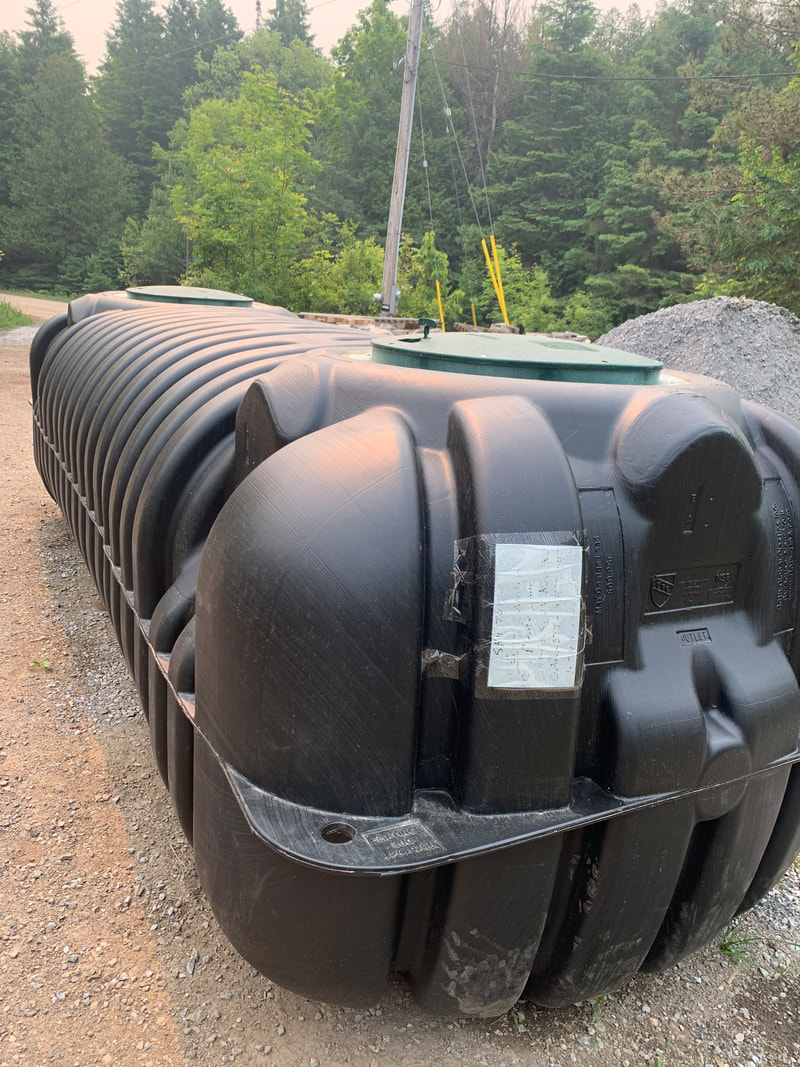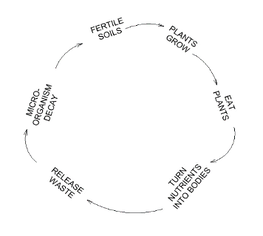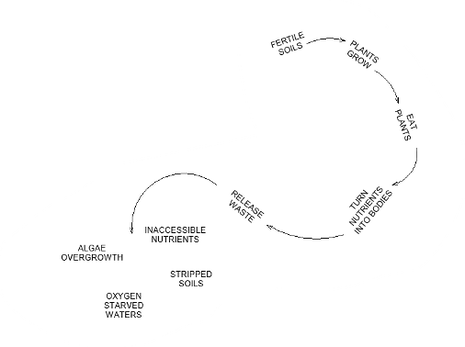 Dear Friends, I'm incredibly pleased and humbled by the success of our recent Open House, celebrating the official unveiling of the Plenty Canada CampUs. It was a wonderful day of celebration, good conversation, and reflection on our collective responsibility towards Indigenous peoples, truth and reconciliation, the environment, and ourselves. If you were there, thank you very much for coming out! And if you weren't, no problem. I'd still like to thank you for keeping up with the development of the CampUs, from its conception to completion. Your support means the world, wherever you happen to be! The more I reflect upon the events of the past few weeks, the more excited I am for the future of our organization. Not only do I firmly believe that the CampUs has a bright future ahead of it as a physical legacy and meeting space, a place for people of all backgrounds to congregate, but I also believe that it can act as a standing representation of our deeply held values. As stated in some of our past communications, Plenty Canada is striving to further decrease our carbon output, rendering our organization even more Energy Negative than it already was! True to our mandate, the CampUs was built in its entirety with sustainability in mind: siding and roofing to prevent air leakage, a rainwater collection system, an Energy Recovery Ventilator (ERV), and more. We've installed solar panels on the roof of our second Lanark building and our Six Nations Bureau office is also adding a new solar system that will have capacity to charge an electric car! But despite our recent advances, I'd like to remind you all (and myself) that these values we cherish should not be optional. As the leader of an Indigenous organization, I feel that this commitment, this unshakable mandate, is a responsibility we must carry with us. The principle of Two-Eyed Seeing, fusing an Indigenous perspective on the environment with the best of Western science, simply cannot remain theoretical, not when our collective future is at stake. Thus, we will continue to embody our values in everything we do, until our entire country chooses to embody them as well. As a result, we challenge all of our partners, organizations and individuals, to plan and resource your own energy neutral existence. Chi Miigwech. Niá:wen. Merci. Thank you. Larry McDermott, Executive Director, Plenty Canada
0 Comments
Plenty Canada had been anticipating its October 21st Open House for many months, finishing up renovations and advertising the event numerous times on its various social media channels. Given the importance of the CampUs when it comes to Plenty Canada’s future as a carbon negative organization, it was critically important that the Open House went off without a hitch. First impressions are important, after all, and the organization wanted to ensure the public that the new space would be ready for any possible set of activities.
For almost 40 years, Plenty Canada’s office has served as an important gathering place for cross-cultural work. Over the past two years this remote rural headquarters has been transformed into a site that features significant solar energy generation, environmentally sustainable windows and siding, new sustainable heating and water systems, newly furnished rooms for classes and lodgings, and much more. Luckily, the event was a smashing success! The overcast, slightly chilly weather didn't deter the numerous attendees one bit. The attendees weren't just from the local area either. Some travelled hours to visit the Open House, including representatives from the Bruce Trail Conservancy, the Niagara Escarpment Biosphere Network, and our Six Nations office in Southern Ontario. Gathering under a large tent that was rented for the occasion, everyone came together for a series of wonderful presentations from experienced elders and educators, in between opportunities to tour the transformed CampUs buildings. Programming ran from 9:30 in the morning with an opening address from Executive Director Larry McDermott, to 3:30 in the afternoon with a follow-up talk by Larry on the future of the CampUs. It is difficult to pick a single highlight among all the fascinating presentations. As previously mentioned, Tim Johnson and Amanda Harwood came up from Plenty Canada's Six Nations Bureau and provided a fantastic update on the Great Niagara Escarpment Indigenous Cultural Map. The visitors were also treated to a talk from celebrated Cuban Indigenous educator and long-time Plenty Canada collaboratorJose Barreiro, on Plenty Canada's Maya-Guatemala project, which empowers Indigenous women in the region to preserve their ancestral knowledge and values. Of great interest, of course, was Plenty Canada's CampUs reveal that took place immediately following the opening address, along with the announcement that the new building was officially certified Net Zero just a few days before the event. In fact, the organization as a whole is now Energy Negative! In a program entitled Carbon Negative: The Sun Is Our Sources, recent testing has revealed that Plenty Canada nailed its net zero qualifying numbers, with a reduction from 9 to .75 (a lower number indicates a greater degree of air tightness). With the addition of 72 more solar panels the goal is to inspire other organizations and individuals to do their part to mitigate climate change while demonstrating to other not-for-profits, businesses, and even individuals, that achieving carbon neutrality or even negative carbon status is possible. Other programs focused on Healing and Legacy Places, Land-Based Learning, Youth Programming, Community Based Governance of the Niagara Escarpment Biosphere Network, Indigenous Perspectives on United Nations Sustainable Development Goals, Language Preservation, and Two Eyed Seeing To Share Knowledge of Ontario’s Breeding Birds. Visitors were given the chance to tour through all of the rooms within each building. From the new accessible stairway and beautiful cobblestone walkway outside, to the sustainable energy systems and multiple rooms renovated for educational programs, offices, and lodging inside, pretty much everything about the buildings was brand new for most every visitor. The integrated design of the interior and exterior programming spaces was beautiful. Overall, it seems that the new CampUs was a big hit! Those involved in the process are extremely grateful for the positive reception to the unveiling of the CampUs. Every single compliment meant the world to members of the staff; the organization will work hard to make sure that upcoming programming at the Plenty Canada CampUs lives up to the early hype. You won't have to wait long for news on new programming. With energy from the sun and water supplied by nature the complex has been activated. — Breton Campbell and Tim Johnson Weaving family love, fostering abundance, and promoting unity are fundamental pillars for improving the living conditions of Q'eqchi communities in Guatemala. In this endeavor, we value ancestral knowledge and the importance of unity as key elements for progress and the recovery of our people. One of the first steps is access to clean water, a crucial priority on this path to well-being. By ensuring a sufficient water supply, we free up time spent searching for it, allowing us to dedicate it to tending gardens and developing handicrafts, which represent a significant source of income for Q'eqchi women. Combating diseases caused by the consumption of contaminated water becomes a significant step in improving the quality of life and health in our community. Malnutrition, a concerning issue for our families, can be addressed through water harvesting, enabling the production of fresh and healthy foods to nourish our loved ones. With water as a fundamental resource, we forge a more promising future for generations to come. Also, proper waste management is crucial in these steps towards improving the quality of life for the beneficiaries, as many families currently have septic tanks that lead to illnesses and pose short and long-term environmental contamination to Mother Earth. Weaving family love, producing abundance, and maintaining unity are the foundations upon which we build a path to a better future for our people. Through access to clean and safe water, better waste management and give the appropriate techniques we unlock the potential of our communities, empowering women and combating malnutrition. In ancestral knowledge and unity, we find the strength to confront current challenges and create a prosperous and harmonious future for all. Since the beginning of the Dignified Life project in early 2022, my understanding has grown regarding how to provide dignified conditions for Maya grandmothers from whom I have acquired significant knowledge about spirituality, customs, and ancestral traditions. This led me to initiate a project focused on improving the housing conditions of these wise grandmothers. However, along the way, I have encountered various paradigms and situations that money or economics can solve or resolve entirely. From my position as the director of such a loving and culturally rooted Maya ancestral project, I can act from my heart and initiative, which I consider a blessing and a gift from my ancestors. Challenges have grown, particularly in terms of encountering various social and community issues, lack of unity, undervaluation of support, and, above all, individualism within certain aspects of the communities. Revitalizing Maya Q'eqchi Indigenous Communities with a Sustainable Focus and Ancestral ValuesThe revitalization of Maya Q'eqchi Indigenous communities is a significant endeavor that seeks to blend modern techniques with the valuable ancestral values of our culture. This journey has been enriching and challenging, particularly in the realm of project management, requiring ongoing learning and time. After thorough diagnosis and deep immersion in our Maya communities, a substantive model has been established as a foundation for a comprehensive program. In 2023, we will apply this model with more certainty, hoping for even more positive outcomes. We have successful examples, innovative techniques, and a trained team, all supported by a robust plan that strengthens the social change we seek. Our organization's essence in community building, the willingness to collaborate and work together, just as our ancestors did with the ancestral principle of reciprocity. We encourage the revitalization of our customs and ancestral knowledge, recognizing that social change is achieved by embracing this concept and teaching it to the people in our communities. Reciprocity provides us with strength and promotes unity among us, fostering the motto "Today for you, tomorrow for me." We believe that by keeping the youth interested in these traditions and knowledge, we ensure the continuity and sustainable growth of our communities. Our goal is to work for three to five years in two communities, establishing them as exemplary models to inspire and support more Maya communities in the future. As a director, I commit to continuing my quest for technical and professional knowledge in areas such as Permaculture and Bioconstruction. This training will enable me to lead our sustainable community development efforts more efficiently and effectively, in harmony with nature and our ancestral traditions. In the first semester of 2023, we continued to monitor the constructions carried out in 2022, using methods of observation and ongoing training to ensure optimal results in the new techniques implemented for rainwater collection, water sanitation through filtration, and the management of both black and gray wastewater using filters called wetlands. Throughout this process, we have observed and confirmed the optimization of resources, the positive changes in the lives of the beneficiaries, and the successful outcomes of the installed systems. During this period in 2023, we executed two additional constructions as "pilot projects," employing techniques different from the previous ones. This allowed us to once again observe which techniques are the most effective and adaptable for the communities. Furthermore, we provided training and education to the construction team and the beneficiary families, promoting a significant shift in resource management. The beneficiary families of these projects reside in the Esperanza Chison community, located in the municipality of Carcha, Alta Verapaz, Guatemala. These families now have a proper system for rainwater collection, a water sanitation system, proper management of both black and gray wastewater, as well as bathroom and shower facilities connected to a filtration system.Additionally, construction was carried out using bio-architecture techniques. These projects have had a positive impact on the community, which consists of over 200 families. These families have shown genuine interest in learning these techniques and improving the conditions of their homes, as well as adopting effective waste management methods. Young individuals from the q'eqchi community have approached both projects with the aim of learning more about the filtration process for graywater sanitation, intending to implement these systems in their own homes. Thus far, the impact has been positive and has demonstrated that the communities have a strong desire to improve and develop in a clean environment, taking care of both their homes and their surroundings. This represents a significant step toward sustainable development, in which permaculture plays an essential role in the community improvement process. This report presents the results and progress achieved during the "Dignified Life: Revitalization of Maya Q'eqchi Indigenous Communities" project. Focused on improving living conditions and sustainable development in our communities, this project is based on ancestral values and the pursuit of unity as a means to achieve a prosperous and harmonious future for Mayan Qeqchies grandmothers and the new generations. Biodigester SystemIn our pilot project, we implemented a biodigester system, which is essentially a structure that allows controlled decomposition of organic matter, such as manure and food waste, in an oxygen-free environment. This is known as anaerobic digestion. At the core of our biodigester are microorganisms, especially methanogenic bacteria, responsible for breaking down these waste materials and producing biogas as a result. Our biodigester is a sustainable solution for organic waste management, preventing these wastes from becoming environmental pollutants. Instead of releasing greenhouse gases and unpleasant odors, we capture the decomposition gases in the biodigester and convert them into biogas. This biogas is a valuable source of renewable energy. We collect and store it for later use. The primary component of biogas is methane (CH4), which is a clean and efficient fuel. We utilize it in various ways in our community, such as an energy source for cooking, electricity generation, and, in some cases, as vehicle fuel. The biogas production process also carries significant environmental benefits. It helps reduce environmental pollution by capturing decomposition gases and converting them into a useful energy source. Additionally, it contributes to climate change mitigation by preventing the release of greenhouse gases into the atmosphere. In our project, we ensure the successful operation of the biodigester by maintaining optimal conditions for microorganisms. We control temperature, nutrient balance, and pH to ensure that microorganisms thrive in their ideal environment, working efficiently. One of the most rewarding aspects of this project is its community involvement. We train local people in the use and maintenance of the biodigester, enabling them to actively participate in the process and reap the benefits of biogas in their homes. Training and Valorization of Typical Maya Q'eqchi Weaving as a Source of Income for Maya WomenThe training project aimed at valorizing traditional Maya Q'eqchi weaving was carried out with the goal of preserving and promoting the cultural traditions of this Indigenous community while providing a sustainable source of income for Q'eqchi women. Below, we present the key results of this project. Training and Skill Development: A series of workshops and training sessions were conducted, covering traditional techniques of weaving, dyeing, and designing typical Q'eqchi textiles.During the project, the following results were achieved: Improvement in Weaving Skills: Participating Q'eqchi women demonstrated significant progress in their weaving skills. They learned new techniques and perfected traditional ones, enabling them to create higher-quality and aesthetically beautiful pieces. Knowledge of Natural Dyeing: Training was provided on natural dyeing techniques using local resources, allowing participants to create vibrant and unique colors in their textiles. Ancestral knowledge and unity within the Q'eqchi people constitute fundamental pillars for addressing current challenges and building a prosperous and harmonious future for all. These two elements are deeply rooted in our cultural and traditional identity, and their value is immense in the pursuit of sustainable and resilient solutions, passed down through generations over centuries, is an invaluable treasure for our community. It holds accumulated wisdom on the sustainable management of natural resources, appropriate practices for our environment, craftsmanship, and medicinal techniques, among other aspects. Rescuing and valuing this knowledge provides us with a significant advantage in seeking alternatives that promote prosperity and the preservation of our environment. Unity, on the other hand, provides us with collective strength to face the challenges that come our way. When we work together as a united community, we can overcome obstacles, share resources and knowledge, and confront adversities with greater resilience. Unity enables us to make consensus based decisions and develop collaborative projects that benefit everyone, thus reinforcing our social cohesion and solidarity. At the intersection of ancestral knowledge and unity, we find a powerful synergy. By recognizing and valuing the richness of our traditions and ancestral wisdom, we strengthen our sense of belonging and cultural self-esteem. This empowers us as a community, promoting respect and appreciation for our individual and collective identities. The wisdom accumulated over generations provides us with a solid foundation for addressing present challenges. We can find solutions tailored to our local context, harnessing our natural and cultural resources sustainably. At the same time, unity allows us to work together in implementing these solutions, sharing complementary skills and knowledge to comprehensively address the issues we face. In the process of building a prosperous and harmonious future for communities, the preservation and revitalization of ancestral knowledge and the promotion of unity are essential. By recognizing and respecting our cultural heritage, we empower ourselves to embrace innovation and adaptation without losing our identity. By working together as a cohesive community, we become stronger and more resilient in the face of the challenges we encounter, paving the way for a sustainable and equitable future for all members of our Q'eqchi community. Uplifting the spirits of customs and knowledge. Social change is reciprocity, a concept that needs to be re-taught to people because it gives us strength, and unity is born from it. "Today for you, tomorrow for me," and that is what gives us strength as a community. Keeping the youth engaged is essential. A three to five year effort to work in two communities, setting them as models for more Maya communities. Well-functioning project, to have people who are capable of working but lack this cultural and Indigenous awareness and responsibilityIn the four projects executed so far, my experience in constructing bioconstruction models for houses and bathrooms has shaped my thinking about bioconstruction. It involves the revaluation of ancestral construction methods, contact with Mother Nature, minimal to zero carbon footprint, and accessibility to housing improvements and living conditions. It is a construction method and branch that should be economically accessible. Regarding permaculture, it must be a core part of the project to ensure the sustainability of community development initiatives over time.
A Mayan community development project in harmony with nature doesn't require exorbitant amounts of money. It requires energy and effort and unity; sustainability doesn't have to be expensive. With natural resources, we can observe that it is careful project planning and discipline that can provide sustainability, eco-friendliness, and energy efficiency. Sustainability must be accessible to Maya communities. Therefore, along with the board members, we have decided to focus our action plan for the coming months in 2023 without changing our vision and mission, always fueled by our enthusiasm and dedication to each project. Initially, we believe it's essential to find and train a team that has a sense of cultural belonging, a desire to be part of this change in the human conditions of indigenous peoples, and the intention to train and make them a permanent part of the team. By building unity from within, we can create unity outwardly. The second mission during this upcoming period is to establish a collaborative trust network based on reciprocity with board members and community leaders (cocodes) in the two model communities where we have worked over the past three years. Once our trust network and activist team in Bioconstruction and Permaculture are established, we will continue to build more sanitary facilities, housing, and improve living conditions related to access to rainwater and energy. Project Fundamentals: Weaving Family Love, Fostering Abundance, and Promoting Unity: The project centers on three fundamental pillars: weaving family love, fostering abundance, and promoting unity. These ancestral values form the foundation of our communities and pave the way for a better future. Access to Clean Water and Sustainable Development: Access to clean water is a priority for the well-being of our communities. Liberating time spent searching for water allows a focus on productive activities like tending to gardens and engaging in artisanal work. Moreover, the fight against diseases resulting from contaminated water improves the quality of life and health. Combating Malnutrition and Improving Quality of Life: Access to clean water makes possible the production of fresh and healthy food, combating malnutrition and enhancing the nutrition of our families. Thus, water becomes the fundamental resource for forging a promising future. Importance of Ancestral Knowledge and Unity: Value of Ancestral Knowledge: Ancestral knowledge is an invaluable treasure passed down through generations. Rescuing and valuing this knowledge provides us with advantages in the search for sustainable solutions and harmonious development. Strength of Community Unity: Unity provides us with collective strength to face challenges. Working together enables us to overcome obstacles, share resources, and confront adversities with resilience, promoting social cohesion. Achievements and Challenges: Significant Achievements: We have established a substantial model for the project based on ancestral values and sustainabledevelopment. Four projects have been executed with positive results, demonstrating that it is possible to improve living conditions while respecting traditions. Faced Challenges: We have identified a lack of unity and limited appreciation for support within the communities. Bioconstruction and permaculture present challenges, such as excessive expenses and the need totrain experts in ancestral methods. Steps Towards a Promising Future: Revitalization Strategy: The strategy focuses on finding and forming a team with a sense of cultural belonging and awareness. Training in bioconstruction and permaculture is key to achieving lasting changes. Focusing on Awareness and Reciprocity: The project will concentrate on raising awareness about the importance of reciprocity and unity. This awareness will drive collaborative actions and strengthen the community from within. Prioritizing Unity and Loyalty: Establishing a collaborative network of trust with model communities is fundamental. Internal unity will enable projecting unity outward, creating an environment of trust and cooperation. Sustainable Construction and Permaculture: Emphasis will be placed on sustainable construction and permaculture as pillars for sustainable community development. Training an exclusive team in these areas will ensure efficient and sustainable projects. Conclusions: The revitalization of Maya Q'eqchi indigenous communities relies on ancestral values, knowledge, and unity. Cultural awareness, reciprocity promotion, and collaboration are key to building a prosperous and harmonious future. Next Steps and Planned Actions: - Formation of a team trained in bioconstruction and permaculture. - Establishment of a collaborative trust network with model communities. - Continuation of construction projects and quality-of-life improvements. - Focus on awareness and promotion of reciprocity and unity. This report reflects our commitment to sustainable development and the preservation of our ancestral values. We thank everyone who has been part of this journey and look forward to continuing to work together for a promising future in our Maya Q'eqchi Indigenouscommunities.
 Over the summer, the two Indigenous Community Liaisons (Sharon Kimberley, Northern Ontario and Martina Albert, Southern Ontario) worked to expand community outreach, sharing project information with Indigenous communities and to develop programming activities in concert with interested groups. The community outreach strategy was to build on existing contacts and develop newrelationships by attending pow wows, anniversary events, and other gatherings. Booth materials, hand-outs, posters, and communications were all developed, and were well received. There was a lot of excitement over the draws for binoculars that were held at every event the Indigenous Community Liaisons attended. Many people enjoyed looking at the materials, checking out their favourite birds in a copy of Atlas-2 that was on hand for sharing bird stories. The give-away bird stickers were a big hit with both young and old! Activities and events were held in different communities in Ontario. Sharon, the North Liaison, travelled to Fort Severn to facilitate a knowledge exchange between Atlas bird surveyors who had paddled down the Fawn and Severn rivers to Fort Severn, and meet Fort Severn community members. The exchange was lively, with information shared from all participants. The grandmothers told amazing stories of knowing exactly to the day when the snow geese would return. The snow geese return is not as predictable now due to climate change. Bird monitoring training and nature walks also occurred throughout the province. The Sustainable Development team, plus the Youth Land Guardians from Timiskaming First Nation came to the Hilliardton Marsh for a day of bird monitoring training and bird banding. It was a truly educational experience for all involved. Beaverhouse First Nation welcomed Atlas participants and Sharon for their Family Day. The Atlassers led a youth nature walk, inspiring the young people with all their bird stories and knowledge. Martina, the South Liaison, travelled to various powwows and other community events acrosssouthern Ontario. Educational events included a youth birding workshop with Chippewas of the Thames First Nation, where youth learned how to use birding equipment and record survey data, and a birding hike at the Neyaashiinigmiing Powwow. The project has also supported bird surveying for Webequie First Nation and Alderville First Nation. Are you an Indigenous person interested in hearing more about the Two-Eyed Seeing Knowledge Sharing project? If so, please contact Sharon Kimberley at sharonkimberley@plentycanada.com. — Emily Morris and Sharon Kimberley Plenty Canada is always remarkably busy -- to the point that it can often be difficult to properly acknowledge and discuss all of the events and programming it carries out over the course of a year. On that note, this past year the organization has successfully carried out a number of Indigenous languages and cultures workshops and trainings, all of which were healthily attended and packed to the brim with amazing conversations and learning opportunities.
For instance, from the 19th to the 22nd of May, Plenty Canada hosted their “Language, Food, and Medicine Gathering” at the Perth Civitan and the Plenty Canada CampUs; a four-day gathering attended by over 50 participants. True to the format of many of our multi-day workshops, the gathering featured talks and activities on a number of diverse topics, unified by their celebration of Indigenous cultures. After an opening ceremony led by Larry McDermott, the first day kicked off with a traditional medicines workshop led by Algonquin Elder (and longtime Plenty Canada collaborator) Roy Paul, and his partner Shirley St. Pierre. This was followed up by talks on Indigenous food sovereignty and a training session on Ethical Space led by Gary Pritchard. Gary’s session gave participants a chance to learn about how to cultivate Ethical Space, especially in conservation and environmental spaces, and how to create meaningful engagement and relationships between Indigenous and non-Indigenous peoples. The following days of the gathering more than lived up to the promise of the opening day, with highlights including traditional Mohawk beading with Liv Rondeau, “The Spirit of Harvesting” with Dan Longboat, sturgeon traditional knowledge and preparation with Curtis Lazore, a mushroom foraging workshop with Alyssa General and Levi Grant, a Grandfather teaching and storytelling with Elder Vince Pawis, drumming with Barry Sarazin and his Algonquin drum group, and a cooking workshop led by award-winning Inuk chef, Trudy Metcalfe-Coe (who also provided nightly feasts throughout the gathering). This wasn't the only elaborate, multi-day and multi-stage workshop we hosted this year, of course --and it won't be the last. Plenty Canada’s “train the Trainer” gathering from March 12th-14th focused on sharing language and cultural knowledge between Elders/Knowledge Keepers and other Indigenous community members, and featured many similar activities as the May gathering, such as a traditional medicines workshop, drumming, foraging, beading, cooking, as well as hide-tanning, and land-based learning via a nature hike led by Kayla Sunday. And rest assured, Plenty Canada already has a host of similar programming in the works. In addition, we have been busy working with Indigenous Language experts on Indigenous languages revitalization. This year, we hosted an Anishinaabemowin (Algonquin language) class for the second year in a row, as well as a Kanien’kéha (Mohawk language) class, for the first time! We have also been working on a second Algonquin language guidebook, to be completed soon. Keep an eye on this website and our social media channels for news on these projects, and meanwhile keep an eye on the “Resources” section of our website for professionally recorded videos of some of these workshops, as well as the Algonquin language guides to be published online soon. — Emily Morris  It is almost surreal to think that I'm writing this letter to you now. After years of hard work and cooperation, and so many incremental improvements (many of which were talked about in this Contact newsletter), the Plenty Canada CampUs is almost ready to be unveiled. Really, I could act even more surprised that we pulled this off, but that would imply that our success was due to luck. In actuality, it was due to nothing more than the combined determination and cooperation of many exceptional people -- including people like you, our donors and supporters! It might be a cliche, but hard work really does pay off. For those of you not already in the know about how this project came to be, at this point it might be valuable to give you a bit of a “crash course” on the CampUs -- its origins, its development, and our plans for its future. Given that we had a second building on our property which was rarely used, and a host of workshops and other community outreach activities that could do with an expansion, we thought it would be a great idea to transform that building into a space dedicated to holding these workshops, increasing Plenty Canada’s capacity to act as a hub for Indigenous and environmentalist activities in the region. Of course, this plan would have never gotten off the ground without the Federal Economic Development Agency for Southern Ontario -- a thousand thanks to them for believing in the potential of this project. We thought that a gradual approach would work best, so we set out to work on adding incremental, environmentally sustainable improvements to Plenty Canada’s HQ: environmentally sustainable windows and siding, new sustainable heating / water systems, newly furnished rooms for classes and lodgings, and much more. I hope you'll stick around to read some of the following articles, which will go into more detail about the specifics. As of right now, the CampUs is ready for use, but will continue to evolve, adding even more features such as a kitchen area for Indigenous cultural food projects. As a whole, the building is an expression, a culmination, of both Plenty Canada's core values and the principle of “Two-Eyed Seeing” — using Indigenous knowledge and Western science to solve societal issues. Using scientifically honed building materials and additions, we've created a space that will ideally service as a meeting ground for Indigenous and non-Indigenous peoples from all walks of life, a space where they can educate themselves on the work required for true reconciliation and environmental sustainability, and to use this education to better the world around them. Thank you again for cheering us on throughout this entire process. Please enjoy the following issue of our newsletter—a “victory lap” of sorts—and look forward to future updates on the space as it grows to even greater heights. In particular, we will be holding an Open House event in the fall, so please stay tuned to your email and Plenty Canada’s website! Chi Miigwech. Niá:wen. Merci. Thank you. Larry McDermott, Executive Director, Plenty Canada Though we’re still very much in the midst of making improvements to the Land-Based Learning Centre that constitutes the Plenty Canada CampUs, the area still looks like a construction site, I thought I’d draft a quick update on our progress so far as we work toward completion in the fall. To provide a little perspective on work completed this past winter, here is what the Makwa Inn (second building in the CampUs complex) looked like mid-January before construction on the building envelope got in full swing: The most notable sustainable improvements can’t be seen in the photo — these are hidden under all the green siding. What is under the siding and galvanized steel roof is a building envelope that was engineered to be a continuous air barrier. Air barriers are one of the key ways in which all buildings can reduce energy waste and cost while preventing the negative environmental impacts of heating and cooling structures. The term “air barrier” doesn’t just refer to one material; it is a system of materials that are installed in a specific manner to stop air leakage caused by variations in air pressure and temperature. The more openings there are in an air barrier, the more leakage a building will have, and the more energy is wasted. Given that we were looking to mitigate our overall impact on the environment when renovating the building, installing a continuous air barrier was essential. For an air barrier system to work optimally, the system must be continuous and include insulation with a high R value. (R value is the rating given to insulation indicating its ability to resist heat flowing through it.) In addition to reducing costs of heating and cooling, a continuous air barrier contributes to reducing greenhouse gas emissions while preventing pollutants, debris, insects, and other animals from finding ways in through openings in the building envelope. Our building team was up to the task of creating a continuous air barrier on all four exterior walls as well as the roof. The attention to detail was immense, in order to ensure that the components installed will prevent air from passing through the barrier. This was a major undertaking, with a team of four crewmembers working full time for over three months to complete the project this winter. The following photos show the process of creating the air barrier around the building envelope: Next, the team went on to make great improvements to the roof, to prevent air leakage and infestation from local wildlife in the future. We initially had budgeted for minor work to the roof, but on closer inspection we realized that, over the years, wildlife had occupied the attic, leaving little insulation. We undertook a plan to make improvements to the roof, which has prevented air leakage and increased the quality and quantity of insulation, with a combination of a 6” depth of Roxul “Comfortboard” and dense pack cellulose. After the envelope was completed in April we prepared for the window and door installation. One of the most common, and preventable causes of wasteful air leaks in buildings is around doors and windows. The team applied multiple layers of sealants and tapes, to again create “air barriers” around all windows and doors to prevent air leaks. These efforts contribute significantly to reducing home heating and cooling costs and are a big part of reaching net zero emission goals. The work on the CampUs will continue for the foreseeable future. As we progress, we’ll be sure to share updates with you.
We are proceeding with the net zero certification and will look to install a solar apparatus onto the roof of the Makwa Inn that will produce enough energy to completely offset the energy use of all appliances, including the new heat pump, HRV (Heat Recovery Ventilator), ERV (Energy Recovery Ventilation) and air cleaning systems. We’re very much looking forward to having this work recognized with Net Zero certification. In the coming months, Plenty Canada will complete multiple landscaping projects, including native plant installations, a new entrance, a porch and stairs, and the completion of the interior of the Makwa Inn, with new drywall, paint, and local white cedar trim for windows and doors. In August, new kitchens made in Canada with Canadian yellow birch, and local black cherry countertops will be installed, creating a beautiful place to gather and practice Two-Eyed Seeing, where knowledge is shared with generosity, kindness, and respect. — Louise Sherwood, sustainable building coordinator 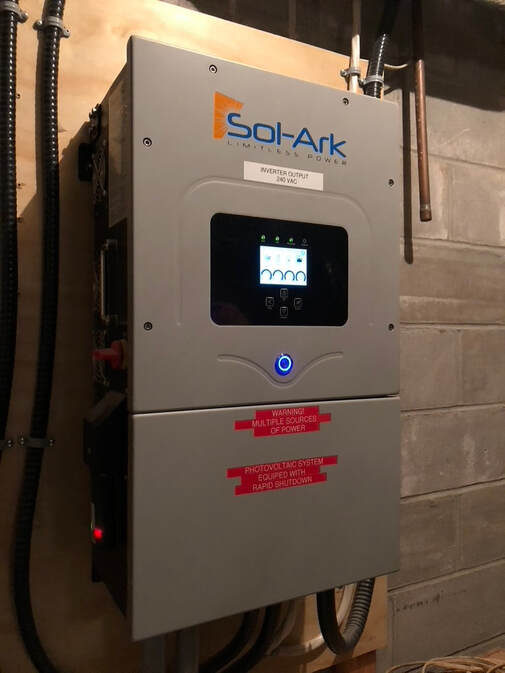 Sol-Ark inverter. Sol-Ark inverter. Plenty Canada doesn’t just want to create a new educational space that symbolizes environmentally friendly aspirations — we want to put in the work in order to turn the building into a living embodiment of those principles. Which is why, throughout the renovation process we strive to work towards a Net Zero certification for the new building. As you may know, buildings that have obtained a Net Zero rating produce net zero greenhouse gas emissions, rendering them completely environmentally friendly. To accomplish net zero goals, Plenty Canada is following the guidelines recommended by the Net Zero Home Labelling Program, created and continually refined by the Canadian Home Builders' Association. In essence, the CHBA provides a series of specific technical requirements that are needed to recognize a new home as Net Zero, or an existing building as Net-Zero ready. Once the building has been built or renovated, its Net Zero status needs to be verified by multiple sources, including the CHBA, the builder or renovator, a net zero service organization, and a qualified net zero energy advisor. As you can probably tell, it's not exactly a quick and uncomplicated process (especially when it comes to retrofitting old buildings that weren't created to match these standards), but Plenty Canada was eager to take on this challenge. Already, the team has made fantastic progress. One of the metrics determining the potential efficiency of a net zero building is the “airtightness” of the building, measured with a decimal number. Before the organization started the renovations, the building was tested by HomeSol and the result was high, rated as a 9. After installing the continuous air barrier, installed new windows and doors ensuring air tightness to the best of our capabilities, we had HomeSol return to do another test on May 24. This test revealed we had nailed our net zero qualifying numbers, with a reduction from 9 to .75! (a lower number indicates a greater degree of air tightness). We then decided to proceed with an Aero Barrier application that promised to enhance airtightness by filling any smaller openings that were previously not filled. After the Aero Barrier was applied the number was reduced to 0.24 — the equivalent of adding up all the tiny air leaks throughout the building, that equals a 5.9 square inch hole. As long as the continuous air barrier remains intact, the building is approximately 75 percent more air-tight than what is required by the Ontario Building Code. With the addition of solar energy supply, the Makwa Inn is well on its way to accomplishing Net Zero Energy Certification. — Breton Campbell & Louise Sherwood Editor's note: Garrett Johnson of Plenty Canada designed and installed three systems that follow the conservation pattern demonstrated by nature. Nature operates on what is called a closed loop system, where nothing is wasted, only returned to the cycle itself to sustain and strengthen the system. The three systems return what is often considered waste: rainwater and human sewage. We asked Garrett to enlighten us with some knowledge about these fascinating systems that are now part of Plenty Canada’s land-based learning centre. Constructed WetlandPart of our responsibilities when existing with other non-human species is to respect our impact when releasing waste into the environment. Rural properties are generally not connected to centralized infrastructure like sewers in the city. Instead, they depend on septic systems or outhouses to dispose of their waste. Both approaches end up releasing our sanitary waste onto or into the ground, and often the contaminants and nutrients from our bodies end up in groundwater supplies or surface water supplies. In many instances, it is desirable to have an extra level of treatment for these sewage systems beyond a standard absorption trench system. In Ontario, these systems are all proprietary method that require ongoing maintenance agreements with delegates of suppliers. There is currently no non-proprietary method for an extra level of treatment. Plenty Canada designed and constructed a system called a “constructed wetland” or “engineered wetland,” which is essentially a sand filter in a basin in which the underground root zone of plants stays permanently saturated, to allow wetland plants to thrive and help out with the treatment of water. The system at Plenty Canada was not the first in the region — the Rideau Valley Conservation Authority office uses a similar system for their sewage treatment. Rainwater Harvesting System Thousands of litres of clean water fall from the sky onto your house every year. The rainwater harvesting system at Plenty Canada’s Makwa Inn safely collects and stores this water for use inside the house before using it and releasing the water back to the earth. This system is intended to be used as an example to showcase an alternative approach to supplying our homes and bodies with clean water. Given that many remote rural communities no longer have clean sources of drinking water due to industrial and agricultural pollution in ground and surface waters, this could act as a viable alternative method of gathering water. North Americans often view rainwater as a hazardous source, however, in other countries the perception is often quite different. In Australia, for example, millions of modern homes use rainwater either as a supply to offset potable use, or as the sole source of water with city infrastructure as a backup. With a few simple guidelines, it is easy to collect and store a safe supply of rainwater that should not pose a risk to health — and, with a bit more filtration, can be a great source of potable water. These small-scale systems can have huge benefits to municipal infrastructure and can also act as a path toward self-sufficiency in areas that are not connected to a municipal supply. Composting Outhouses
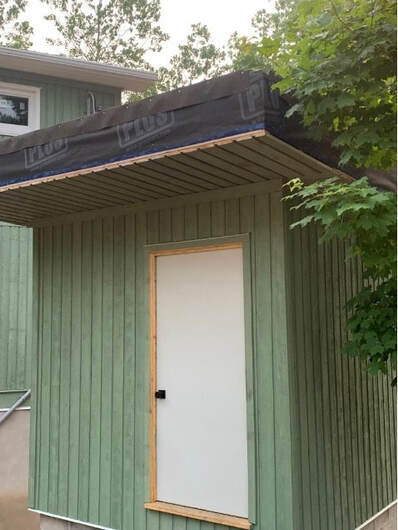 Our first composting outhouse will be completed with a living roof, a wheel chair accessible ramp and full accessible bathroom inside. Our first composting outhouse will be completed with a living roof, a wheel chair accessible ramp and full accessible bathroom inside. Plenty Canada has built a composting outhouse as a small-scale solution to this issue. The waste from visitors to the facility will be collected, stored, safely converted to stable compost (as in, a form that does not readily leach nutrients into groundwater) and put back onto the land. While Plenty Canada has not yet progressed to grow food with outhouse compost, we will showcase the methods which people (or groups of people) can safely close the nutrient cycle. — Garrett Johnson, sustainable building (water management system) Though there is an electric charging station within a 20-minute drive from Plenty Canada (a set of public use units in Perth), only having one charging station within this fairly spread-out rural area often comes with its own unique difficulties. For instance, tow trucks lugging in electric cars that couldn't make it to a charger in time are a common occurrence around the Lanark and McDonald's Corners area; it seems that even veteran drivers of these vehicles can often have trouble navigating between the sparse charging stations that dot the countryside.
This is merely an anecdote, of course, but it speaks to the deep need for robust infrastructure to support alternatives to fossil fuels, especially in areas of the country that are often overlooked in this regard. Now that Plenty Canada has firmly established itself as a carbon-negative organization, a living testament to the viability of solar energy, they would also like to become a local advocate for electric vehicles as well. As a result, Plenty Canada has recently been researching the potential installation of an EV charging station to accompany its new CampUS. Given that the organization expects a surge of new visitors to the office after the CampUs has been opened, now is the perfect time to offer a much-needed utility to both new friends and dedicated supporters. And with more and more vehicles becoming electric, the new chargers will, ideally, both support and hasten this trend, sending a message to the entire country that a world without fossil fuels is very much within our reach. — Breton Campbell, senior writer |
|
-
Home
- Donate
-
Projects
-
Canada
>
- Niagara Escarpment Biosphere Network
- Great Niagara Escarpment Indigenous Cultural Map
- Greenbelt Indigenous Botanical Survey
- The Healing Places
- Indigenous Food Sovereignty
- Plenty Canada CampUs
- Two-Eyed Seeing Bird Knowledge
- Indigenous Languages and Cultures Programs >
- Wild Rice
- Good Mind Grappling
- Ginawaydaganuc Village
- Youth Programming >
- Caribbean >
- Central & South America >
- Africa >
-
Canada
>
- News
- Resources
- Partners
- Contact Us
Our LocationPlenty Canada 266 Plenty Lane Lanark, Ontario, Canada K1G 3P4 (613) 278-2215 |
Donate to Plenty Canada |
Subscribe to our Newsletter |

